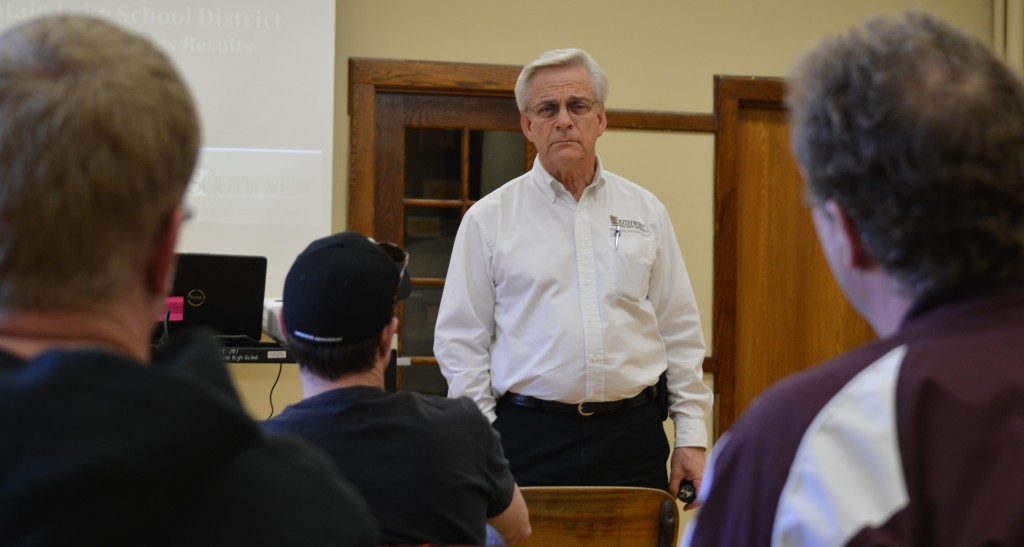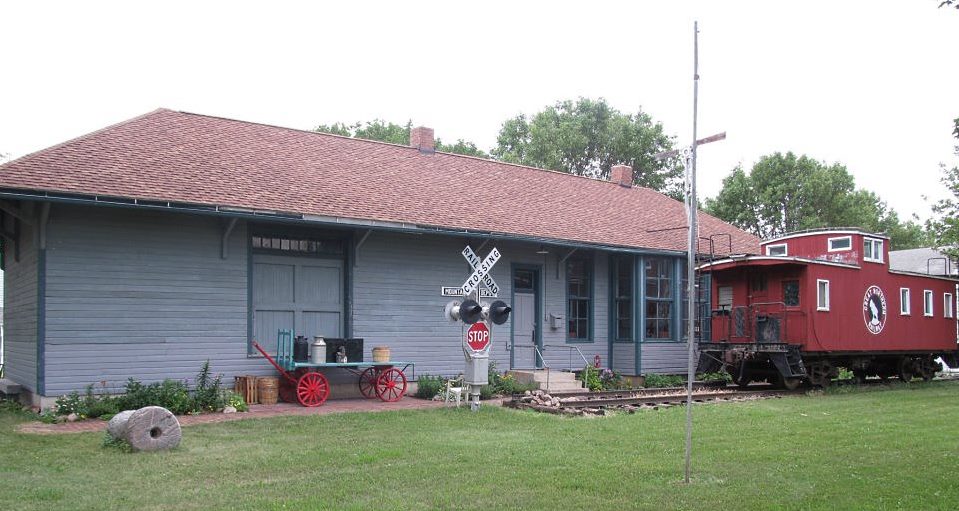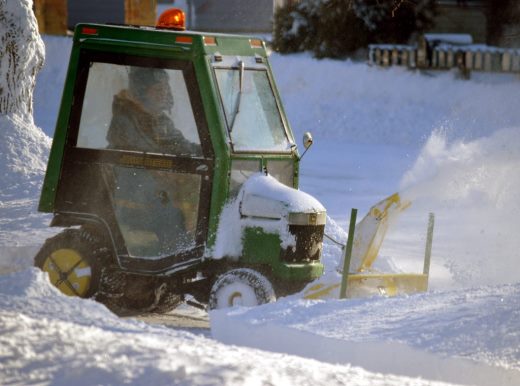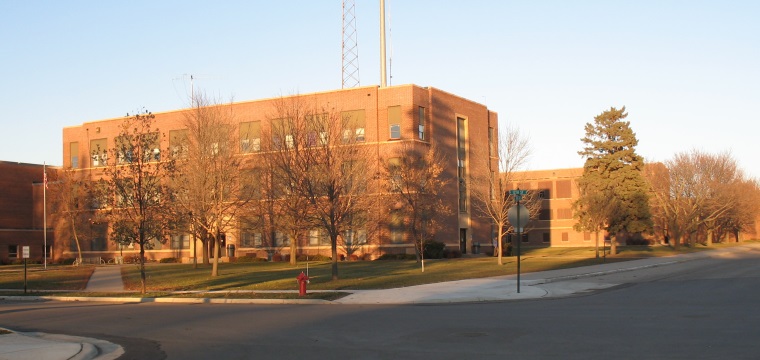Dr. Michael K. Rich: ‘Reassuring to us’ that majority of respondents believe community can come together on building reform consensus

The data collected on the first – of what will probably be three surveys conducted by the Southwest Marketing Advisory Center (SMAC) from Southwest Minnesota State University-Marshall (SMSU) – were released to the public this week during four informational meetings – two held Tuesday, April 8 and again on Thursday, April 10. The results were presented earlier to the Mountain Lake Public School Board.
The answer to one of the questions posed in the survey – one that stood out to the SMAC team – was the lopsided percentage of school district survey respondents (77% strongly agree/agree to 23% strongly disagree/agree) who believe that the community can come together to form a consensus concerning a new Mountain Lake Public School (MLPS) building bond referendum. According to Michael K. Rich, PhD, SMAC Executive Director, “That high of a positive percentage was reassuring to us – as we (SMAC) come to the table from a neutral position – insomuch as the information continues to reach the public in transparent fashion.” Graduate and undergraduate members of SMAC who are working on the MLPS project – all of whom are students at SMSU – include Jonathan Woehl and Maria Gilland, Account Executives, along with Jenna Radke, current Managing Director, as well as Sarah Gass, who will become Managing Director following Radke’s graduation from college this spring.
The SMAC team held community meetings last fall, and followed up on those information-gathering sessions with their initial survey, which was sent to MLPS District residents of voting age, based on questions asked and answered at the forums. Responses were sent in via mail, as well as answered online. The end result of that work was what was presented at this week’s public sessions: “MLPS Preliminary Survey Results.”
The survey included public attitudes concerning the December 2012 failed building bond referendum, public perceptions about the current condition of the buildings of the school campus, the public’s desirability of an acceptable level of school renovations versus constructing a new building and the perceptions about the school district, including educational programs.
Of the 1,582 surveys mailed out to district residents of voting age, 557 were returned; 546 via postal mail and 11 returned online. According to Woehl, that percentage equated to a response rate of 35%, which is “a higher number than is typical in similarly-monitored surveys.” In fact, Dr. Rich stressed that there was a strong response from all interest groups.
Of the respondents, 52% were female, 48% male. A clear majority – 65% – were age 51 and older, which Dr. Rich noted is a typical “rural Minnesota thing.” Sixty-five percent also related to the number of survey respondents who had lived in the school district for more than 25 years. Fifty-seven percent of those answering and returning the survey had a household size of 2-3 family members.
In summarizing SMAC’s conclusions to the survey results, Dr. Rich and Woehl gave an expanded explanation of each point in the group’s conclusions:
* The main reason for the failure of the December 2012 building bond referendum vote was the cost. When combining the 59% who strongly agreed the cost was the cause, with the 19% who agreed with that position – that percentage of 78 proved why the vote was as lopsided as it was against the referendum. In fact, 60% (30% strongly agree, 30% agree) of those returning surveys believe that the referendum exceeded the needs.
* More than half of respondents began seeing any information on the building bond referendum three months or less prior to the vote. This point correlated with the high number of “no” votes, with voters rejecting the referendum 75% to 25%. In addition, breaking down the “yes” and “no” voters, 91% who voted “no” on the referendum, as well as 9% who voted “yes,” thought that the vote on the referendum was rushed.
* Despite the split, 77% of those answering the surveys also believe that the community can come to a consensus about a new bond referendum. Paralleling that belief, stated Dr. Rich, is that “respondents recognize the importance of a school in Mountain Lake for the Mountain Lake community. Combining the strongly agree and agree responses, 67% of respondents feel that Mountain Lake cannot survive without its school. That number is topped with the 82% response of strongly agree/agree that no school in Mountain Lake will mean loss of employment and population – and a decrease in property values. The loss of a school also translates to a feeling by 74% of respondents (strongly agree/agree) that it would also mean the loss of a hands-on role in the students’ educational process.
* Seventy-one percent of respondents believe that consolidation with another area school district is inevitable in 10 years or more into the future. Fifty-eight percent (strongly agree/agree) of those answering the questions in the survey noted that if consolidation occurred, an elementary school would more-than-likely be retained in Mountain Lake. In response to the question if the current condition of the school facilities is a hindrance to consolidation, 57% (strongly agree/agree) that it is. But, 75% (strongly agree/agree) that building improvements would delay consolidation, 63% (strongly agree/agree) that improvements enhance community support and 53% (strongly agree/agree) think that building – along with curriculum – improvements would attract new students. “The right building and program improvements would go a long way to move those students,” stated Dr. Rich. Any improvements would make Mountain Lake more appealing to a consolidation district believed 61% (strongly agree, agree) of respondents. And, as Dr. Rich pointed out, “Mountain Lake could be the controlling school in a consolidation, not vice versa as people’s thoughts first go. Of course, you have to remember, when you consolidate, you consolidate with the debt of the other district.”
* Another interesting piece of information gleaned from the survey results is that 72% of those responding agreed that the best way to communicate with district residents is via direct mail.
* Above all, the majority of respondents (85% strongly agree/agree) that the public needs to be involved with developing a project priority list, including the architect and contractor – but -that the minutiae of details on any project be left to the school board members. Stressed Dr. Rich, “the public does not want any surprises; they want transparency.”
Two more surveys will be taken by the SMAC team. The answers from the next survey will “flesh things out,” explained Dr. Rich. “Will it be a refurb or build a new school? If refurb, what are the top priorities? If it is build, at what level? Then there is the pricing out – and the direction to go on financing.”
The third survey would be what an actual bond referendum ballot would look like.
“Each step can be a healing process for the community,” Dr. Rich concluded, “a bridge over the divide. But for the community to heal with the same purpose as what caused the divide depends on the way it is handled. If the process is done right, the outcome will be accepted. If transparent and handled right, the people will be willing to pay what is reasonable to sustain the school – and town.”

















